
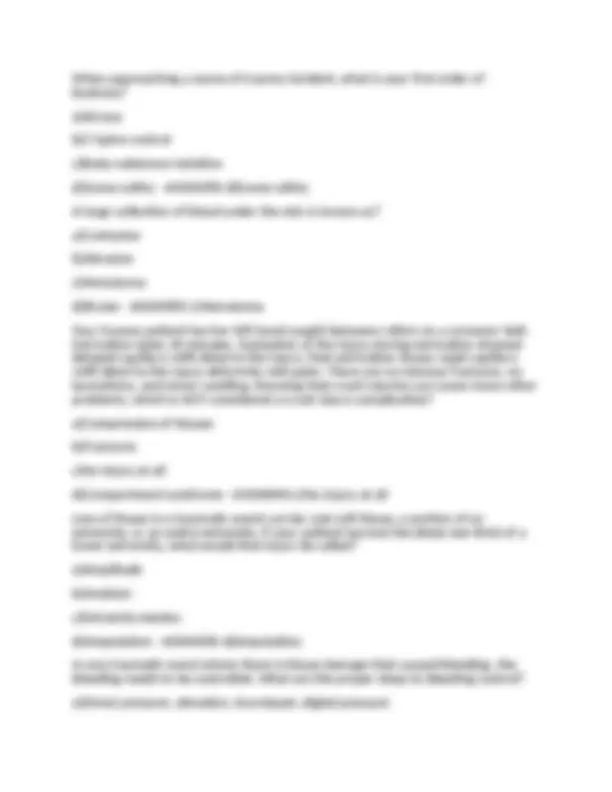
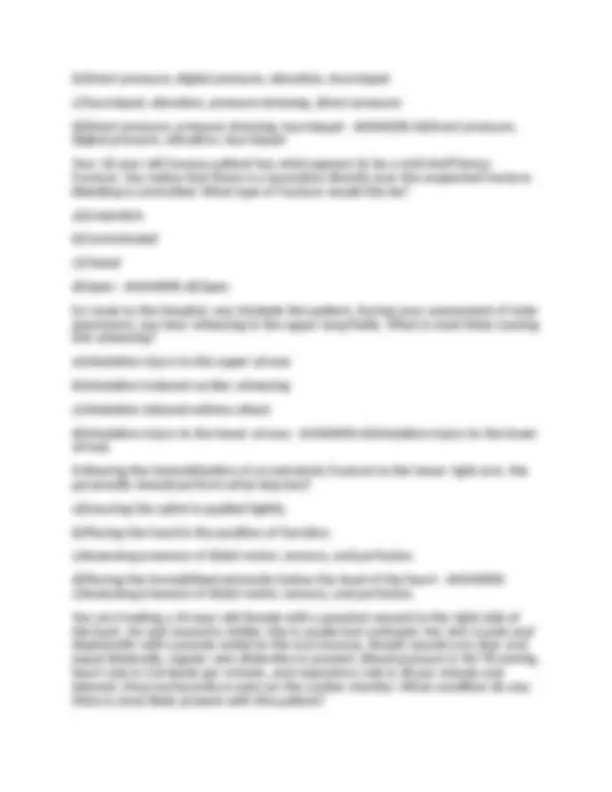
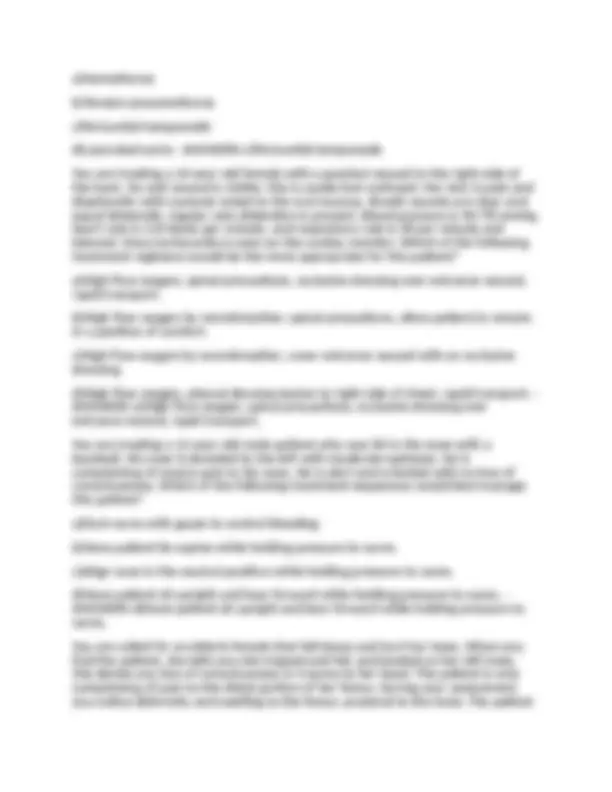


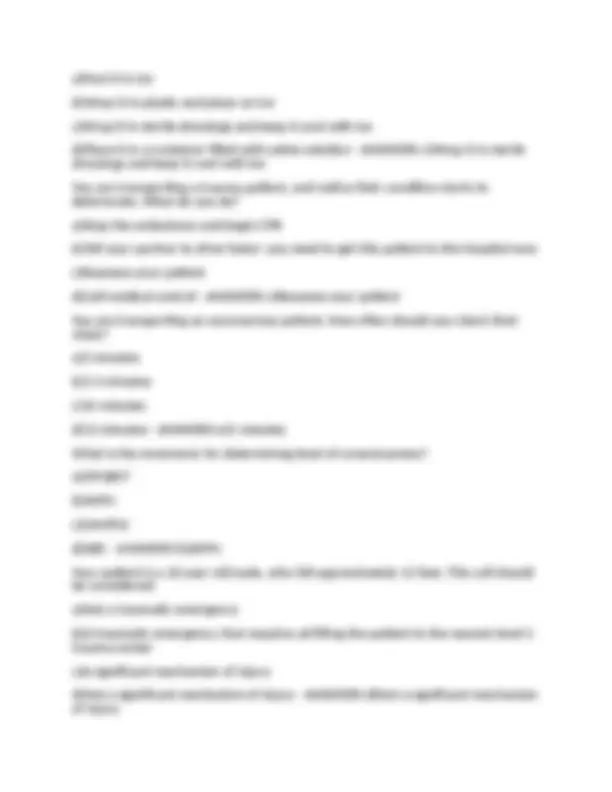

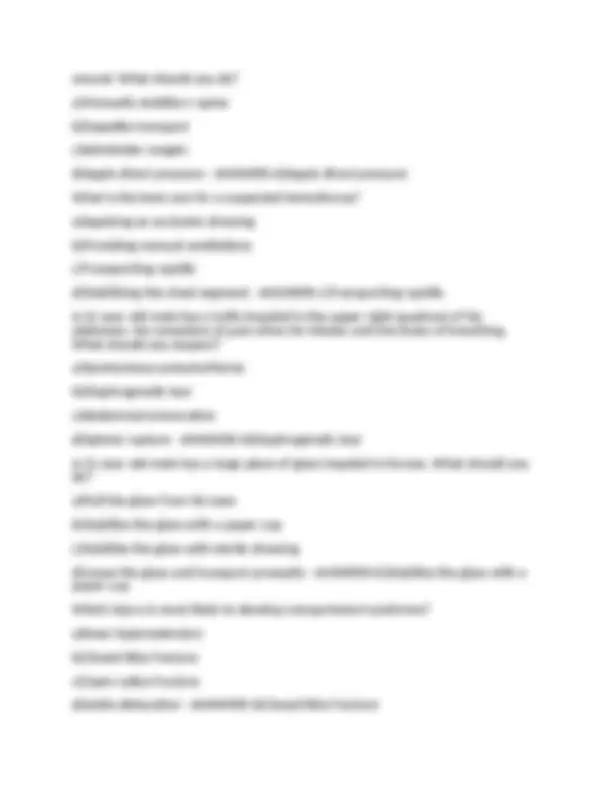





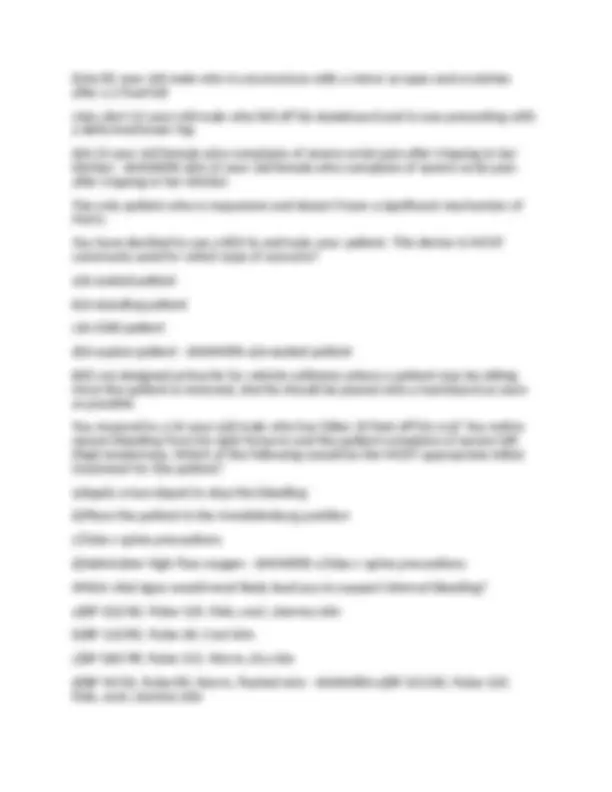
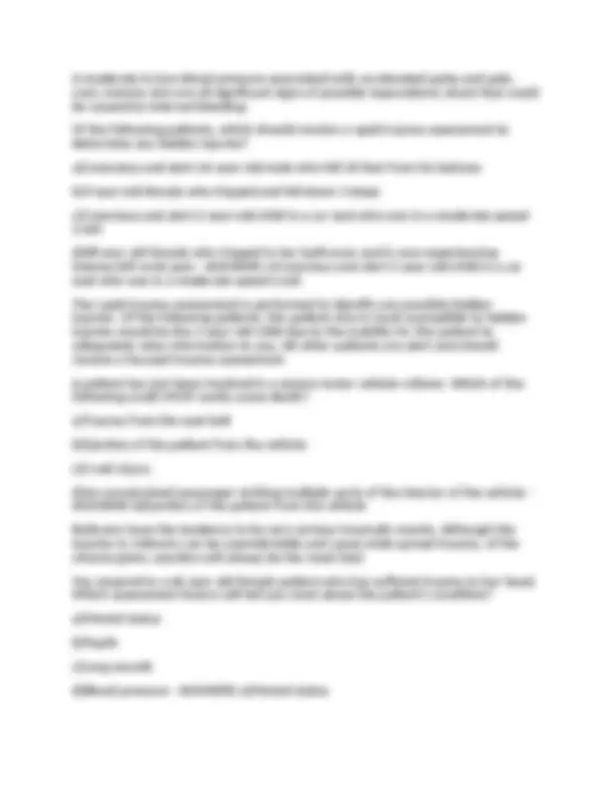
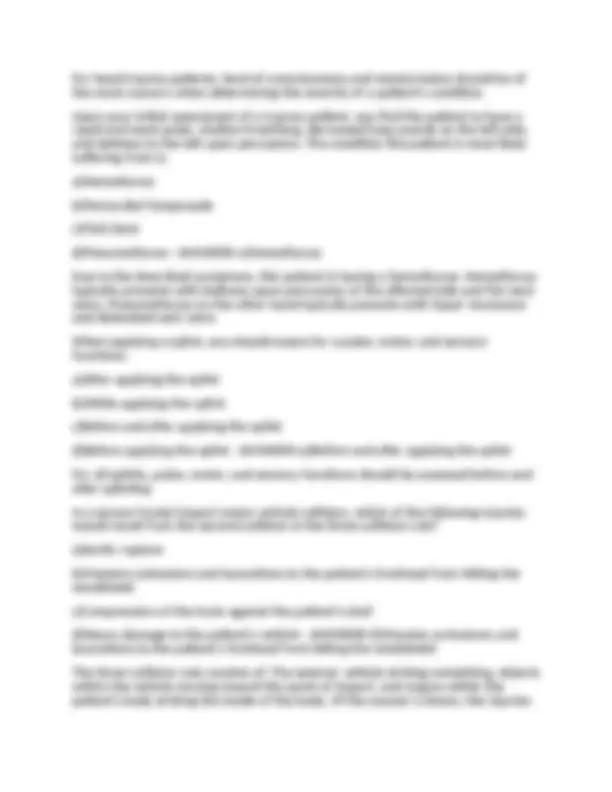
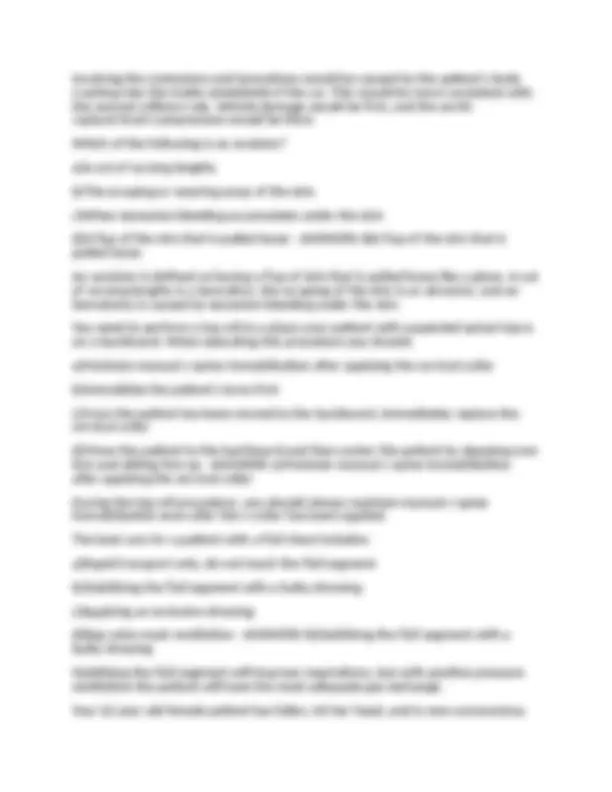
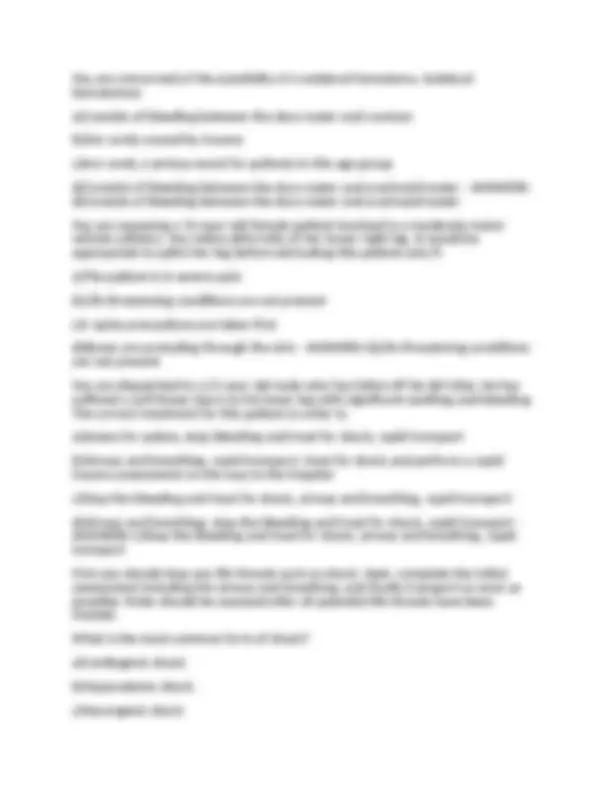
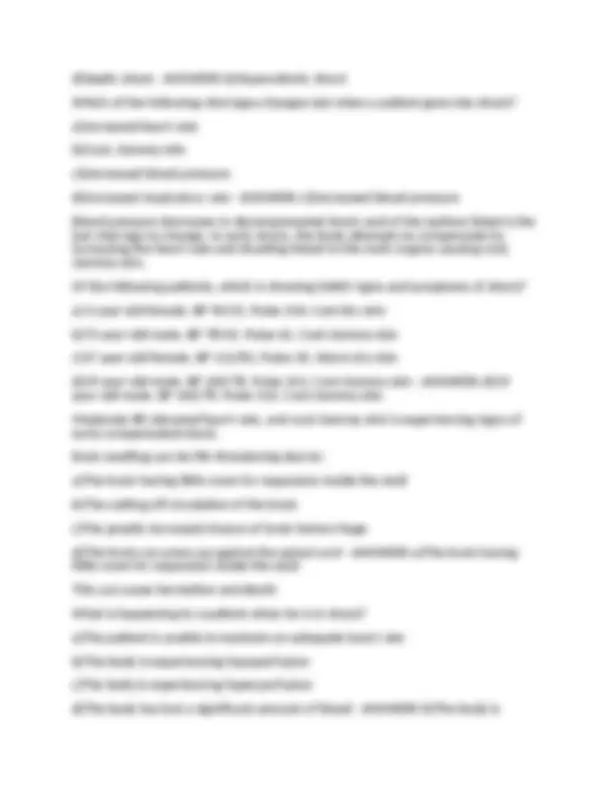
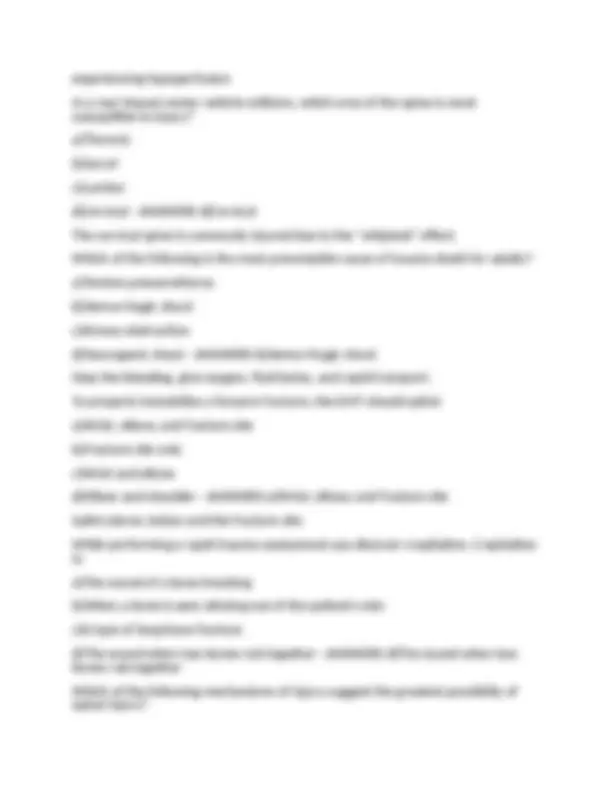
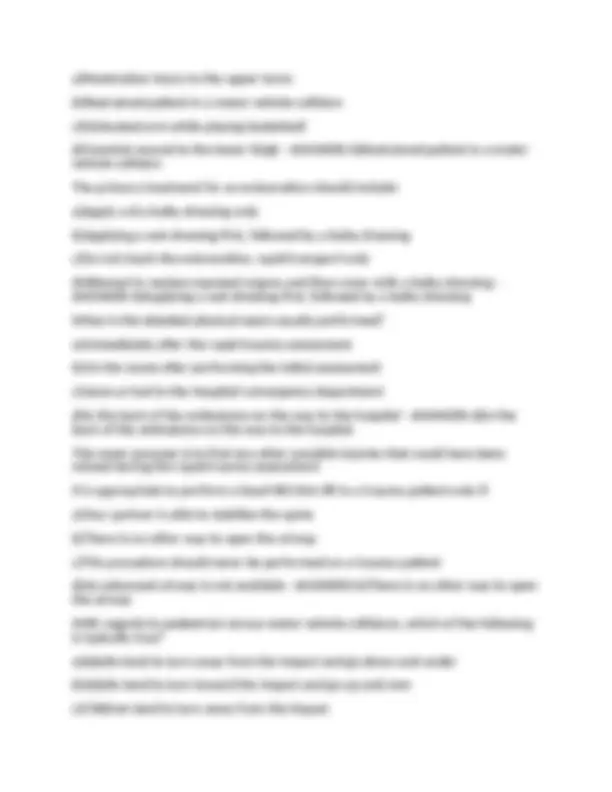
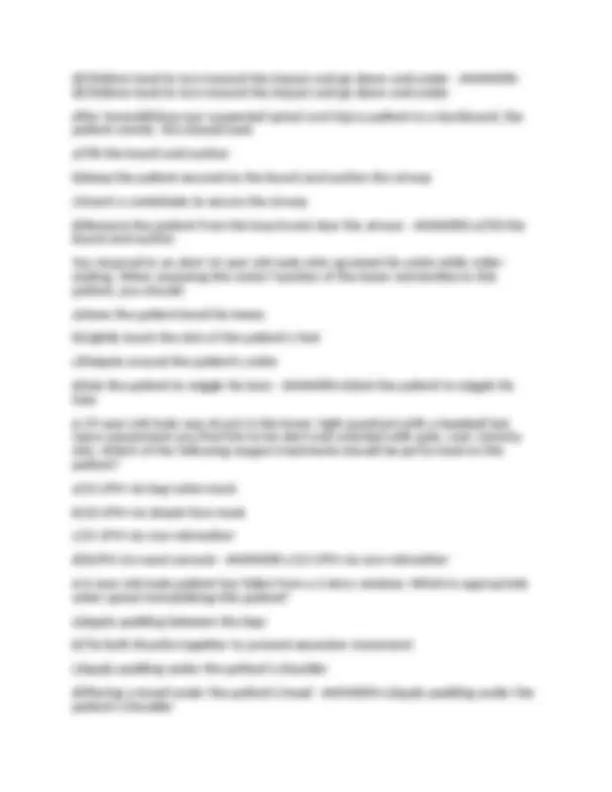
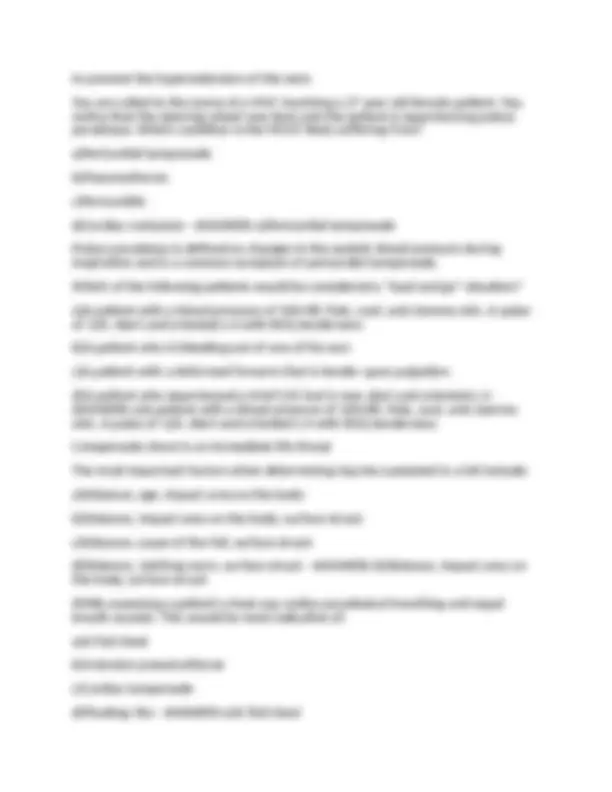
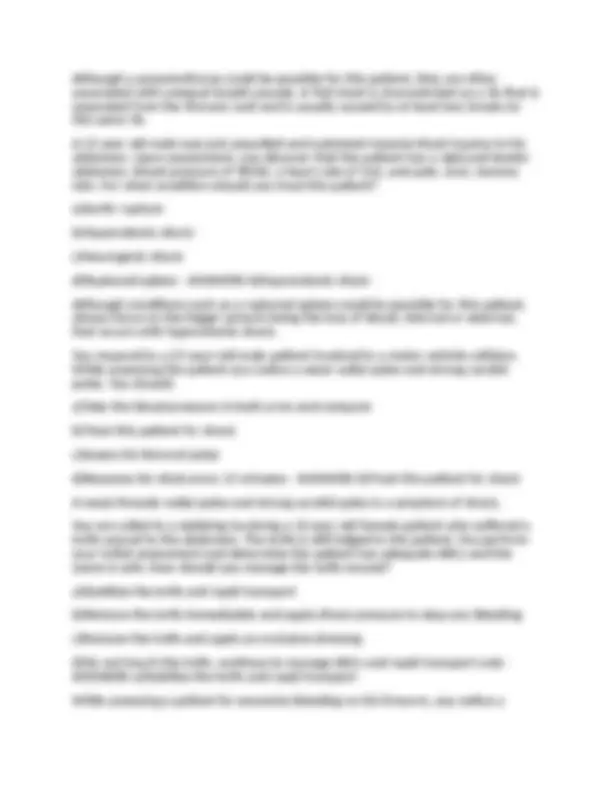
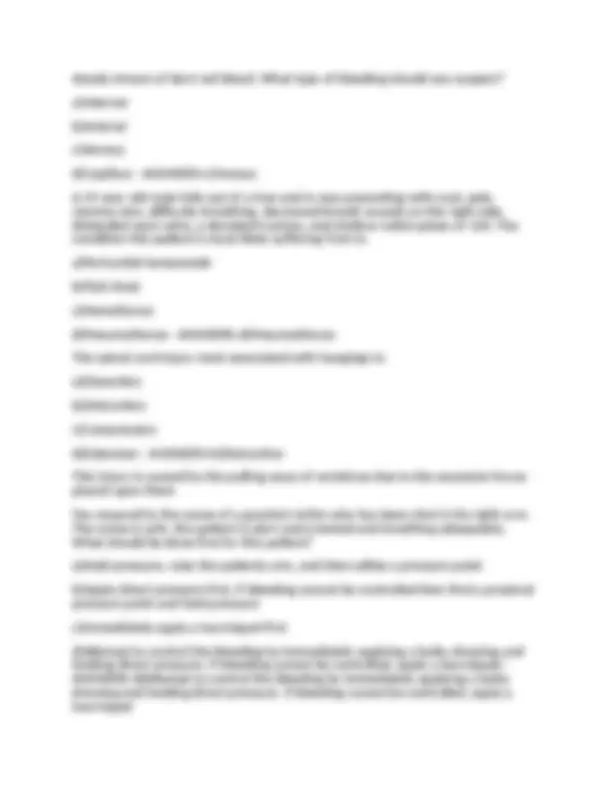
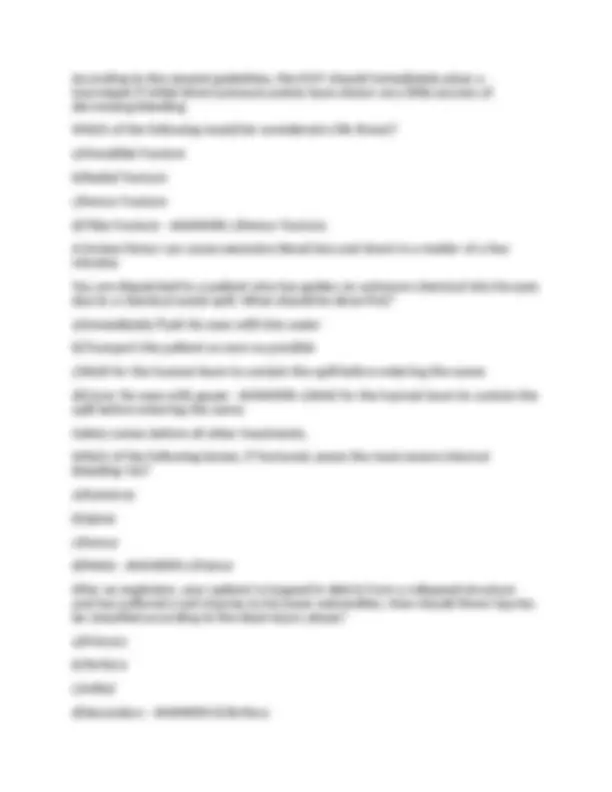



Study with the several resources on Docsity

Earn points by helping other students or get them with a premium plan


Prepare for your exams
Study with the several resources on Docsity

Earn points to download
Earn points by helping other students or get them with a premium plan
Community
Ask the community for help and clear up your study doubts
Discover the best universities in your country according to Docsity users
Free resources
Download our free guides on studying techniques, anxiety management strategies, and thesis advice from Docsity tutors
Trauma fisdap 2025 (50 questions) with answers 100% correct Trauma fisdap 2025 (50 questions) with answers 100% correct
Typology: Exams
1 / 35

This page cannot be seen from the preview
Don't miss anything!




























You arrive on the scene of a patient who fell from a ladder. Which of the following information is NOT an important factor in care of the patient? a)Height of the ladder b)Distance the patient fell from c)Surface the patient landed on d)What part of the body hit first - ANSWERS-a)Height of the ladder You are at the scene of an MVA, in which there are three patients, all of which have minor visible injuries. Two are refusing treatment and the last is complaining of neck and back pain. How should you proceed? a)Treat all three patients, they are visibly injured and need medical attention b)Obtain signed refusals from the first two patients then proceed to the third c)Treat the third patient, nothing else is needed for the other two d)Have your partner obtain refusals from the two patients who refused treatment, while you treat the last patient. - ANSWERS-d)Have your partner obtain refusals from the two patients who refused treatment, while you treat the last patient. Your patient is a 17 year old male found face down in a swimming pool. He is currently being held face up at the surface of the water. He is unconscious but breathing and has a pulse. What is the best course of action for this patient? a)Jump into the pool and begin CPR b)Remove the patient from the pool, immobilize, and transport. c)Apply cervical and spinal immobilization while the patient is still in the pool d)Wait for a trained water rescue team - ANSWERS-c)Apply cervical and spinal immobilization while the patient is still in the pool A laceration, spurting bright laceration, spurting bright red blood, most likely means what type of injury? what red blood most likely means a)Venous b)Arterial c)Capillary d)Amputation - ANSWERS-b)Arterial Your patient has a laceration to the right leg which has intersected the femoral
artery. You have applied direct pressure to the wound, but it continues to soak through the bandages. What should you do next? a)Apply a tourniquet b)Elevate the leg c)Remove the old bandage and apply new ones d)Apply pressure to point just above the injury - ANSWERS-b)Elevate the leg Of the two types of energy, which type of energy transfer in a motor vehicle crash (MVC) with frontal impact, non-restrained driver with bent steering wheel, and spidered windshield? a)High velocity penetrating b)Decelerating c)Low velocity penetrating d)Blunt - ANSWERS-d)Blunt Any penetrating missile traveling over 2,000 ft/sec would be classified as? a)Low velocity b)Medium velocity c)High velocity d)Decelerating - ANSWERS-c)High velocity When there is penetrating trauma there is a permanent cavity which is formed by the projectile contacting the tissues. How is a temporary cavity formed? a)By the twisting of the projectile b)By energy scrubbing off of the projectile c)The wadding entering the body d)Unspent gun powder - ANSWERS-b)By energy scrubbing off of the projectile The way a patient is injured is often referred to as the _______________? a)Mechanism of injury b)Nature of illness c)Injury pattern d)Energy transfer - ANSWERS-a)Mechanism of injury
b)Direct pressure, digital pressure, elevation, tourniquet c)Tourniquet, elevation, pressure dressing, direct pressure d)Direct pressure, pressure dressing, tourniquet - ANSWERS-b)Direct pressure, digital pressure, elevation, tourniquet Your 16 year old trauma patient has what appears to be a mid-shaft femur fracture. You notice that there is a laceration directly over the suspected fracture. Bleeding is controlled. What type of fracture would this be? a)Greenstick b)Comminuted c)Closed d)Open - ANSWERS-d)Open En route to the hospital, you intubate the patient. During your assessment of tube placement, you hear wheezing in the upper lung fields. What is most likely causing this wheezing? a)Inhalation injury to the upper airway b)Inhalation induced cardiac wheezing c)Inhalation induced asthma attack d)Inhalation injury to the lower airway - ANSWERS-d)Inhalation injury to the lower airway Following the immobilization of an extremity fracture to the lower right arm, the paramedic should perform what step last? a)Ensuring the splint is applied tightly. b)Placing the hand in the position of function. c)Assessing presence of distal motor, sensory, and perfusion. d)Placing the immobilized extremity below the level of the heart - ANSWERS- c)Assessing presence of distal motor, sensory, and perfusion. You are treating a 24-year-old female with a gunshot wound to the right side of the back. No exit wound is visible. She is awake but confused. Her skin is pale and diaphoretic with cyanosis noted to the oral mucosa. Breath sounds are clear and equal bilaterally. Jugular vein distention is present. Blood pressure is 90/78 mmHg, heart rate is 124 beats per minute, and respiratory rate is 28 per minute and labored. Sinus tachycardia is seen on the cardiac monitor. What condition do you think is most likely present with this patient?
a)Hemothorax b)Tension pneumothorax c)Pericardial tamponade d)Lacerated aorta - ANSWERS-c)Pericardial tamponade You are treating a 24-year-old female with a gunshot wound to the right side of the back. No exit wound is visible. She is awake but confused. Her skin is pale and diaphoretic with cyanosis noted to the oral mucosa. Breath sounds are clear and equal bilaterally. Jugular vein distention is present. Blood pressure is 90/78 mmHg, heart rate is 124 beats per minute, and respiratory rate is 28 per minute and labored. Sinus tachycardia is seen on the cardiac monitor. Which of the following treatment regimens would be the most appropriate for this patient? a)High flow oxygen, spinal precautions, occlusive dressing over entrance wound, rapid transport. b)High flow oxygen by nonrebreather, spinal precautions, allow patient to remain in a position of comfort. c)High flow oxygen by nonrebreather, cover entrance wound with an occlusive dressing. d)High flow oxygen, pleural decompression to right side of chest, rapid transport. - ANSWERS-a)High flow oxygen, spinal precautions, occlusive dressing over entrance wound, rapid transport. You are treating a 12-year-old male patient who was hit in the nose with a baseball. His nose is deviated to the left with moderate epistaxis. He is complaining of severe pain to his nose. He is alert and oriented with no loss of consciousness. Which of the following treatment sequences would best manage this patient? a)Pack nares with gauze to control bleeding. b)Have patient lie supine while holding pressure to nares. c)Align nose in the neutral position while holding pressure to nares. d)Have patient sit upright and lean forward while holding pressure to nares. - ANSWERS-d)Have patient sit upright and lean forward while holding pressure to nares. You are called for an elderly female that fell down and hurt her knee. When you find the patient, she tells you she tripped and fell, and landed on her left knee. She denies any loss of consciousness or trauma to her head. The patient is only complaining of pain to the distal portion of her femur. During your assessment, you notice deformity and swelling to the femur, proximal to the knee. The patient
d)Paralysis - ANSWERS-a)Pain Your 26-year-old female patient has been pulled out of a house fire. Her chest and arms have been burned. The area is charred and the patient states she has little pain in the burned area. What is the most likely classification of this patient's burns? a)Full thickness b)Superficial partial thickness burns c)Deep partial thickness burns d)Superficial - ANSWERS-a)Full thickness You have responded for a 43-year-old male who was involved in an altercation. The patient was reportedly beaten about the face and head with a baseball bat. The patient is unresponsive. Evaluation of the patient's face reveals instability from the orbits to the mandible. Based on this information, how would you definitively manage this patient's airway? a)Immediately assist ventilations with a Bag-Valve-Mask. b)Orally intubate the patient and assist ventilations with a Bag-Valve-Mask. c)Insert an oral airway and assist ventilations with a Bag-Valve-Mask. d)Insert a nasal airway and assist ventilations with a Bag-Valve-Mask. - ANSWERS- b)Orally intubate the patient and assist ventilations with a Bag-Valve-Mask. When managing an open fracture, you should do which of the following? a)Cover the exposed bone ends with a moist sterile dressing. b)Provide mild manual traction to restore distal circulation. c)Leave the wound exposed if there is no massive bleeding from the area. d)Apply a pressure dressing to prevent blood loss. - ANSWERS-a)Cover the exposed bone ends with a moist sterile dressing. What is the most common spinal injury associated with improper lifting techniques? a)Thoracic b)Cervical c)Lumbar d)Sacral - ANSWERS-c)Lumbar
You respond to the scene of a residential natural gas explosion to find a 36-year- old male patient complaining of a diminished ability to hear, moderate dyspnea, and acute abdominal pain. These symptoms are likely due to what mechanism? a)Primary blast injury b)Secondary blast injury c)Tertiary blast injury d)Toxic inhalation of natural gas - ANSWERS-a)Primary blast injury While assessing the carotid and radial pulse in your unresponsive patient, you determine that the carotid pulse is weak and rapid, and the peripheral pulses are absent. What other clinical assessment finding would you expect to be present? a)An irregular rhythm of the pulse b)A decrease in the respiratory rate c)Cool and pale skin d)An increase in arterial pressure - ANSWERS-c)Cool and pale skin Your patient is suffering from Epistaxis. How should you proceed. a)There is no treatment for Epistaxis b)Pack the area with gauze c)Pinch the nostrils and have the patient lean forward d)Pinch the nostrils and have the patient tilt their head backwards - ANSWERS- c)Pinch the nostrils and have the patient lean forward What are the signs and symptoms of shock a)Increased heart rate, increased respirations, hypotension b)Decreased heart rate, increased respirations, hypotension c)Increased heart rate, decreased respirations, hypertension d)Decreased heart rate, increased respirations, hypertension - ANSWERS- a)Increased heart rate, increased respirations, hypotension Your patient is a 22 year old male with an object impaled in the right side of his chest, just below the shoulder. After assessing that the object is not blocking his airway, what is the best course of action for this patient? a)Remove the object by pushing it through the same direction as it entered b)Remove the object by pulling it back out the way it entered.
a)Pack it in ice b)Wrap it in plastic and place on ice c)Wrap it in sterile dressings and keep it cool with ice d)Place it in a container filled with saline solution - ANSWERS-c)Wrap it in sterile dressings and keep it cool with ice You are transporting a trauma patient, and notice their condition starts to deteriorate. What do you do? a)Stop the ambulance and begin CPR b)Tell your partner to drive faster; you need to get this patient to the hospital now c)Reassess your patient d)Call medical control - ANSWERS-c)Reassess your patient You are transporting an unconscious patient. How often should you check their vitals? a)5 minutes b)2-3 minutes c)10 minutes d)15 minutes - ANSWERS-a)5 minutes What is the mnemonic for determining level of consciousness? a)OPQRST b)AVPU c)SAMPLE d)ABC - ANSWERS-b)AVPU Your patient is a 16-year old male, who fell approximately 15 feet. This call should be considered: a)Not a traumatic emergency b)A traumatic emergency, that requires airlifting the patient to the nearest level 1 trauma center c)A significant mechanism of injury d)Not a significant mechanism of injury - ANSWERS-d)Not a significant mechanism of injury
A fall greater than ______ would be considered a significant mechanism of injury in a patient under the age of 8. a)The height of the patient b)5 feet c)Double the patient's height d)10 feet - ANSWERS-d)10 feet You are called to the scene of pedestrian that's been struck by a car. Upon examination, you notice clear fluid leaking from the patient's ear, that you believe to be cerebral spinal fluid. This tells you the patient may have suffered a: a)Severe head injury b)Basilar skull fracture c)Ruptured eardrum d)Cervical spine injury - ANSWERS-a)Severe head injury What does PMS stand for during your assessment of a patient's lower extremity? a)Pedial , Motion, Sensation b)Pain, Motion, Severity c)Pulse, Motor function, Sensation d)Pulse, Motor sensation, Severity - ANSWERS-c)Pulse, Motor function, Sensation A 34 year old male has a fractured left elbow, and his arm is cyanotic and pulseless. What should you do? a)Stabilize the elbow with a sling and swathe b)Immobilize the arm with a traction splint c)Align with gentle traction until resistance is met d)Immobilize the arm as it was found - ANSWERS-c)Align with gentle traction until resistance is met What is the term for the injury in which the epidermis remains intact, but cells and blood vessels in the dermis may be damaged? a)Contusion b)Evisceration c)Hematoma
c)Concussion d)Convolution - ANSWERS-b)Crush injury Which injury or condition should be managed first in a patient with multi-system trauma? a)Fluid drainage from both ears b)Bleeding within the oral cavity c)A large open abdominal wound d)Bilateral fracture to the femur - ANSWERS-b)Bleeding within the oral cavity A 25 year old male has a deep laceration on his right forearm. You are applying direct pressure with a trauma dressing. But the wound continues to bleed. What should you do? a)Tension pneumothorax b)Apply a tourniquet proximal the laceration c)Align with gentle traction until resistance is met d)Transporting rapidly - ANSWERS-b)Apply a tourniquet proximal the laceration A 46 year old female was in a car crash at highway speeds. She is unconscious, breathing deep and fast with an abrasion to the lateral aspect of her neck. What should you do? a)Take c-spine precautions b)Open the airway c)Perform a rapid extrication d)Apply an occlusive dressing - ANSWERS-a)Take c-spine precautions A 56 year old male complains of tearing chest pain that radiates to his back. He was the restrained driver involved in a car crash at high-way speeds. What should your secondary assessment include? a)Bilateral upper extremity blood pressures b)A deep palpation of the abdomen c)Auscultation for abnormal breath sounds d)A review of the medication list - ANSWERS-a)Bilateral upper extremity blood pressures A 23 year old male was stabbed in the shoulder and blood is spurting from the
wound. What should you do? a)Manually stabilize c-spine b)Expedite transport c)Administer oxygen d)Apply direct pressure - ANSWERS-d)Apply direct pressure What is the best care for a suspected hemothorax? a)Applying an occlusive dressing b)Providing manual ventilations c)Transporting rapidly d)Stabilizing the chest segment - ANSWERS-c)Transporting rapidly A 22 year old male has a knife impaled in the upper right quadrant of his abdomen. He complains of pain when he inhales and shortness of breathing. What should you suspect? a)Spontaneous pneumothorax b)Diaphragmatic tear c)Abdominal evisceration d)Splenic rupture - ANSWERS-b)Diaphragmatic tear A 21 year old male has a large piece of glass impaled in his eye. What should you do? a)Pull the glass from his eyes b)Stabilize the glass with a paper cup c)Stabilize the glass with sterile dressing d)Leave the glass and transport promptly - ANSWERS-b)Stabilize the glass with a paper cup Which injury is most likely to develop compartment syndrome? a)Knee hyperextension b)Closed tibia fracture c)Open radius fracture d)Ankle dislocation - ANSWERS-b)Closed tibia fracture
Which of the following is NOT a high priority condition? a)Poor general impression b)Unresponsiveness c)Severe pain d)Childbirth - ANSWERS-d)Childbirth Your patient has suffered a chainsaw vs. leg injury. His wife who is a nurse tells dispatch that he has lost about 400 mL of blood. You know that a person can lose approximately___________ before they are in any real danger. a)200 mL b)500 mL c)750 mL d)1000 mL - ANSWERS-b)500 mL With regard to the SAMPLE history, a patient's pale skin would be considered __________. a)A sign b)A symptom c)Syncope d)Dermis - ANSWERS-a)A sign You and your partner Hugh arrive on scene to find a car that has hit a tree at approximately 30 miles an hour. There is front end damage to the vehicle and both occupants are still strapped into the front seat. Both airbags in the front deployed and both patients appear to be alert and oriented. What should you do? a)Put them both on high flow O2 with collars on and let them sit in the back of the ambulance on the way b)Treat them at the scene and let them go home c)After putting on collars, put both patients on back boards using a KED sled or similar device d)Insert an oral airway and bag them both at 12-20 breaths per minute - ANSWERS-c)After putting on collars, put both patients on back boards using a KED sled or similar device What is a burn that involves the epidermis and the dermis but no underlying tissue?
a)Partial thickness burn b)Double dermis burn c)Full thickness burn d)Bakers burn - ANSWERS-a)Partial thickness burn What is a hemorrhage? a)Not a cause of shock b)Severe bleeding c)Not a threat to perfusion d)Always the cause of shock - ANSWERS-b)Severe bleeding You and your partner Grimes are called to the scene of a stabbing. There are two patients reported. A woman with a stab wound to the URQ and a man with a stab wound to the LRQ. The woman with the wound in the URQ is having problems breathing, has a pulse of 103, respirations of 35, and they are shallow. The patient with the stab wound to the LRQ is complaining of severe abdominal pain and has a pulse of 48 and a respiration rate of 24. Which patient is most likely to have a low blood pressure? Why? a)The man, because of the nature and location of the injury, he may be losing blood internally. His pulse is too slow as well b)The woman, because if she cannot breathe well her BP will drop c)The man, because a respiration rate of 24 is indicative of low blood pressure d)Neither will have a low blood pressure, they will both be high - ANSWERS-a)The man, because of the nature and location of the injury, he may be losing blood internally. His pulse is too slow as well A 2 year old female has a second degree burns on both palms and third degree burns on her chest and abdomen. What percentage of her body is burned? a) b) c) d)18 - ANSWERS-c) chest - 9 abdomen - 9
a) b) c) d)21 - ANSWERS-c) hands - 2 anterior forearms - 4 (approximately 2 per arm) upper chest - 9 A 22 year old male has isolated and patchy third degree burns. Which classification method should you use to determine the percentage of body area burned? a)Rule of Palm b)Lund and Browder Chart c)Rule of Nines c)Broselow tape - ANSWERS-a)Rule of Palm A 21 year old male fell asleep by the pool for 5 hours. He has bright red burns on his neck and down to his ankles. What percentage of his body is burned? a) b) c) d)36 - ANSWERS-b) chest - 18 anterior legs - 18 anterior arms - 9 A 3 year old male has full thickness burns covering his arms, posterior trunk and right leg. What percentage of burns did he receive? a) b) c) d)50 - ANSWERS-d)
right leg - 14 each arm - 9 back - 18 A 60 year old male was burned in a house fire. He has a partial and full thickness burns to the anterior surface of his neck, chest, and abdomen. What percentage of burns did he receive? a) b) c) d)14 - ANSWERS-b) abdomen - 9 chest - 9 neck - 1 A 42 year old male has circumferential burns on both legs and his genitals. What percentage of his body is burned? a) b) c) d)37 - ANSWERS-d) both anterior legs - 18 both posterior legs - 18 genitals - 1 How does a full thickness burn present? a)mottled white and red areas that are sensitive to cold b)dark red with painful blisters c)red, blistered and extremely painful d)white, waxy and painless - ANSWERS-d)white, waxy and painless A 3 year old female has circumferential second degree burns reaching up to her knees on both legs. What percentage of her body is burned?